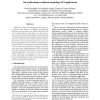Free Online Productivity Tools
i2Speak
i2Symbol
i2OCR
iTex2Img
iWeb2Print
iWeb2Shot
i2Type
iPdf2Split
iPdf2Merge
i2Bopomofo
i2Arabic
i2Style
i2Image
i2PDF
iLatex2Rtf
Sci2ools
IPPS
2008
IEEE
2008
IEEE
On synthesizing workloads emulating MPI applications
Evaluation of high performance parallel systems is a delicate issue, due to the difficulty of generating workloads that represent, with fidelity, those that will run on actual systems. In this paper we make an overview of the most usual methodologies used to generate workloads for performance evaluation purposes, focusing on the network: random traffic, patterns based on permutations, traces, execution-driven, etc. In order to fill the gap between purely synthetic and applicationdriven workloads, we present a set of pseudo-synthetic workloads that mimic applications behavior, emulating some widely-used implementations of MPI collectives and some communication patterns commonly used in scientific applications. This mimicry is done in terms of spatial distribution of messages as well as in the causal relationship among them. As an example of the proposed methodology, we use a subset of these workloads to confront tori and fat-trees
Applicationdriven Workloads | Distributed And Parallel Computing | IPPS 2008 | Mimic Applications Behavior | Pseudo-synthetic Workloads |
| Added | 31 May 2010 |
| Updated | 31 May 2010 |
| Type | Conference |
| Year | 2008 |
| Where | IPPS |
| Authors | Javier Navaridas, José Miguel-Alonso, Francisco Javier Ridruejo Perez |
Comments (0)

